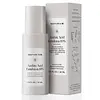What's inside
What's inside
 Key Ingredients
Key Ingredients

 Benefits
Benefits

 Concerns
Concerns

 Ingredients Side-by-side
Ingredients Side-by-side

Water
Skin ConditioningAzelaic Acid
BufferingButylene Glycol
HumectantC12-15 Alkyl Benzoate
AntimicrobialGlycerin
HumectantCaprylic/Capric Triglyceride
MaskingMethylpropanediol
SolventPentylene Glycol
Skin ConditioningIsostearyl Alcohol
EmollientC13-15 Alkane
SolventEthylhexyl Olivate
Skin ConditioningButylene Glycol Cocoate
EmulsifyingNiacinamide
SmoothingAllantoin
Skin ConditioningSebacic Acid
BufferingAcetyl Rheum Rhaponticum Root Extract
BleachingAstrocaryum Murumuru Seed Butter
EmollientGossypium Herbaceum Seed Oil
Skin ConditioningBidens Pilosa Extract
HumectantLinum Usitatissimum Seed Oil
PerfumingAvena Sativa Kernel Extract
AbrasiveCarbomer
Emulsion StabilisingHydroxyacetophenone
AntioxidantSilica
AbrasiveBenzyl Alcohol
PerfumingPanthenyl Triacetate
Xanthan Gum
EmulsifyingSodium Hydroxide
BufferingEthylcellulose
Squalane
EmollientEthylhexylglycerin
Skin ConditioningLactobacillus Ferment
Skin ConditioningSodium Benzoate
MaskingPotassium Sorbate
PreservativeTocopherol
AntioxidantWater, Azelaic Acid, Butylene Glycol, C12-15 Alkyl Benzoate, Glycerin, Caprylic/Capric Triglyceride, Methylpropanediol, Pentylene Glycol, Isostearyl Alcohol, C13-15 Alkane, Ethylhexyl Olivate, Butylene Glycol Cocoate, Niacinamide, Allantoin, Sebacic Acid, Acetyl Rheum Rhaponticum Root Extract, Astrocaryum Murumuru Seed Butter, Gossypium Herbaceum Seed Oil, Bidens Pilosa Extract, Linum Usitatissimum Seed Oil, Avena Sativa Kernel Extract, Carbomer, Hydroxyacetophenone, Silica, Benzyl Alcohol, Panthenyl Triacetate, Xanthan Gum, Sodium Hydroxide, Ethylcellulose, Squalane, Ethylhexylglycerin, Lactobacillus Ferment, Sodium Benzoate, Potassium Sorbate, Tocopherol
Water
Skin ConditioningMandelic Acid
AntimicrobialPropanediol
SolventAminomethyl Propanol
BufferingNiacinamide
SmoothingPolyacrylate Crosspolymer-11
Emulsion StabilisingCaprylyl Glycol
EmollientVaccinium Myrtillus Fruit/Leaf Extract
AstringentSaccharum Officinarum Extract
MoisturisingSodium Hyaluronate
HumectantCitrus Aurantium Dulcis Fruit Extract
MaskingCitrus Limon Fruit Extract
MaskingAcer Saccharum Extract
Skin ConditioningPhenoxyethanol
PreservativePotassium Sorbate
PreservativeXanthan Gum
EmulsifyingHexylene Glycol
EmulsifyingPhenylpropanol
MaskingTocopherol
AntioxidantWater, Mandelic Acid, Propanediol, Aminomethyl Propanol, Niacinamide, Polyacrylate Crosspolymer-11, Caprylyl Glycol, Vaccinium Myrtillus Fruit/Leaf Extract, Saccharum Officinarum Extract, Sodium Hyaluronate, Citrus Aurantium Dulcis Fruit Extract, Citrus Limon Fruit Extract, Acer Saccharum Extract, Phenoxyethanol, Potassium Sorbate, Xanthan Gum, Hexylene Glycol, Phenylpropanol, Tocopherol
 Reviews
Reviews

Ingredients Explained
These ingredients are found in both products.
Ingredients higher up in an ingredient list are typically present in a larger amount.
Niacinamide is a multitasking form of vitamin B3 that strengthens the skin barrier, reduces pores and dark spots, regulates oil, and improves signs of aging.
And the best part? It's gentle and well-tolerated by most skin types, including sensitive and reactive skin.
You might have heard of "niacin flush", or the reddening of skin that causes itchiness. Niacinamide has not been found to cause this.
In very rare cases, some individuals may not be able to tolerate niacinamide at all or experience an allergic reaction to it.
If you are experiencing flaking, irritation, and dryness with this ingredient, be sure to double check all your products as this ingredient can be found in all categories of skincare.
When incorporating niacinamide into your routine, look out for concentration amounts. Typically, 5% niacinamide provides benefits such as fading dark spots. However, if you have sensitive skin, it is better to begin with a smaller concentration.
When you apply niacinamide to your skin, your body converts it into nicotinamide adenine dinucleotide (NAD). NAD is an essential coenzyme that is already found in your cells as "fuel" and powers countless biological processes.
In your skin, NAD helps repair cell damage, produce new healthy cells, support collagen production, strengthen the skin barrier, and fight environmental stressors (like UV and pollution).
Our natural NAD levels start to decline with age, leading to slower skin repair, visible aging, and a weaker skin barrier. By providing your skin niacinamide, you're recharging your skin's NAD levels. This leads to stronger, healthier, and younger looking skin.
Another name for vitamin B3 is nicotinamide. This vitamin is water-soluble and our bodies don't store it. We obtain Vitamin B3 from either food or skincare. Meat, fish, wheat, yeast, and leafy greens contain vitamin B3.
The type of niacinamide used in skincare is synthetically created.
Learn more about NiacinamidePotassium Sorbate is a preservative used to prevent yeast and mold in products. It is commonly found in both cosmetic and food products.
This ingredient comes from potassium salt derived from sorbic acid. Sorbic acid is a natural antibiotic and effective against fungus.
Both potassium sorbate and sorbic acid can be found in baked goods, cheeses, dried meats, dried fruit, ice cream, pickles, wine, yogurt, and more.
You'll often find this ingredient used with other preservatives.
Learn more about Potassium SorbateTocopherol (also known as Vitamin E) is a common antioxidant used to help protect the skin from free-radicals and strengthen the skin barrier. It's also fat soluble - this means our skin is great at absorbing it.
Vitamin E also helps keep your natural skin lipids healthy. Your lipid skin barrier naturally consists of lipids, ceramides, and fatty acids. Vitamin E offers extra protection for your skin’s lipid barrier, keeping your skin healthy and nourished.
Another benefit is a bit of UV protection. Vitamin E helps reduce the damage caused by UVB rays. (It should not replace your sunscreen). Combining it with Vitamin C can decrease sunburned cells and hyperpigmentation after UV exposure.
You might have noticed Vitamin E + C often paired together. This is because it is great at stabilizing Vitamin C. Using the two together helps increase the effectiveness of both ingredients.
There are often claims that Vitamin E can reduce/prevent scarring, but these claims haven't been confirmed by scientific research.
Learn more about TocopherolWater. It's the most common cosmetic ingredient of all. You'll usually see it at the top of ingredient lists, meaning that it makes up the largest part of the product.
So why is it so popular? Water most often acts as a solvent - this means that it helps dissolve other ingredients into the formulation.
You'll also recognize water as that liquid we all need to stay alive. If you see this, drink a glass of water. Stay hydrated!
Learn more about WaterXanthan gum is used as a stabilizer and thickener within cosmetic products. It helps give products a sticky, thick feeling - preventing them from being too runny.
On the technical side of things, xanthan gum is a polysaccharide - a combination consisting of multiple sugar molecules bonded together.
Xanthan gum is a pretty common and great ingredient. It is a natural, non-toxic, non-irritating ingredient that is also commonly used in food products.
Learn more about Xanthan Gum